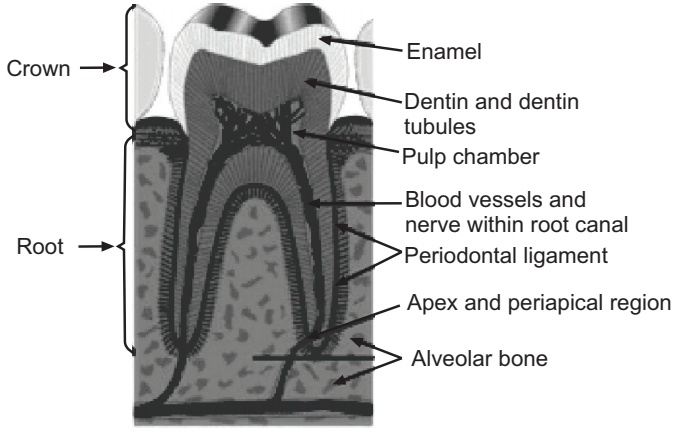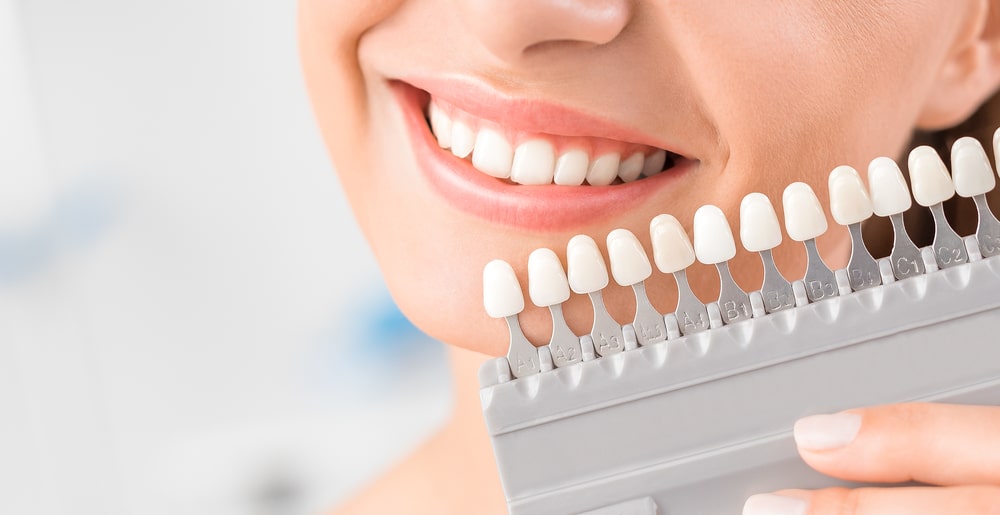Normal Tooth Shade
The appearance and perception of a tooth is the result of a complex interaction of factors such as lighting conditions, translucency, opacity, light scattering, gloss and the human eye and brain. Of these, the intrinsic pigmentation of a tooth is the most influential, which in turn is determined by genetic and natural factors. Light hitting a tooth, undergoes reflection, absorption and transmission by varying degrees in each tissue layer of the tooth substance. Reflected light detected by the human eye determines the perceived appearance of a tooth.

Teeth have a thin enamel layer on the outer surface. The enamel layer is whiter and semitransparent and contributes blue, pink, green tints to the tooth colour. The underlying dentin layer is darker than enamel, yellow-brown in colour, and less transparent. Dentin forms the bulk of the tooth substance and contributes most to the overall tooth colour. At the core of the tooth is soft connective tissue termed the dental pulp. The pulp is pink/red due to its vascularity but is rarely visible through the overlying enamel and dentin unless the thickness of these layers is reduced by tooth wear (or rarely internal resorption). Tooth colour varies according to race, gender and geographic region. Females generally have slightly whiter teeth than males, partly because females’ teeth are smaller, and therefore there is less bulk of dentin, partially visible through the enamel layer. For the same reason, larger teeth such as the molars and the canine (cuspid) teeth tend to be darker. Baby teeth (deciduous teeth) are generally whiter than the adult teeth that follow, again due to differences in the ratio of enamel to dentin.
Discolouration
Tooth discolouration (also termed tooth staining) is abnormal tooth colour, hue or translucency. The external discolouration is an accumulation of stains on the tooth surface. The internal discolouration is due to the absorption of pigment particles into the tooth structure. There are several causes of tooth discolouration, including:
Foods/drinks: Coffee, tea, colas, wines, and certain fruits and vegetables (for example, apples and potatoes) can stain teeth.
Tobacco use: Smoking or chewing tobacco can stain teeth.
Poor dental hygiene: Inadequate brushing, flossing, and rinsing with an antiseptic mouthwash to remove plaque and stain-producing substances like coffee and tobacco can cause tooth discolouration.
Disease: Several diseases that affect enamel (the hard surface of the teeth) and dentin (the underlying material under enamel) can lead to tooth discolouration. Treatments for certain conditions can also affect tooth colour. For example, head and neck radiation and chemotherapy can cause teeth discolouration. In addition, certain infections in pregnant mothers can cause tooth discolouration in the infant by affecting enamel development.
Medications: The antibiotics tetracycline and doxycycline are known to discolour teeth when given to children whose teeth are still developing (before age 8). Mouth rinses and washes containing chlorhexidine and cetylpyridinium chloride can also stain teeth. Antihistamines (like Benadryl), antipsychotic drugs, and drugs for high blood pressure also cause teeth discolouration.
Dental materials: Some of the materials used in dentistry, such as amalgam restorations, especially silver sulphide-containing materials, can cast a grey-black colour on teeth.
Advancing age: On ageing, the outer layer of enamel on the teeth gets worn away, revealing the natural yellow colour of dentin.
Genetics: Some people have naturally brighter or thicker enamel than others.
Environment: Excessive fluoride either from environmental sources (naturally high fluoride levels in water) or from excessive use (fluoride applications, rinses, toothpaste, and fluoride supplements taken by mouth) can cause teeth discolouration.
Trauma: For example, damage from a fall can disturb enamel formation in young children whose teeth are still developing. Trauma can also cause discolouration to adult teeth.
To minimize discolouration, simple lifestyle changes may be adapted. For example, cutting down tea, coffee/smoking albeit all tobacco-based products. Improving dental hygiene by brushing, flossing, and using a mouthwash daily; and getting teeth cleaned by a dental hygienist every 6 months are useful approaches at a personal level.
Make sure you also check our other amazing Article on : Tooth Sensitivity
